Click on images to enlarge
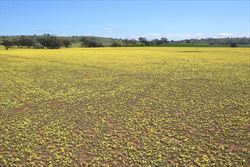
large infestation (Photo: Sheldon Navie)

infestation (Photo: Sheldon Navie)
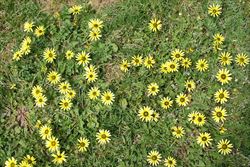
infestation growing in a lawn (Photo: Sheldon Navie)

habit (Photo: Sheldon Navie)
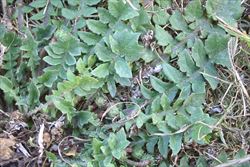
elongated leaves and young flower-heads (Photo: Sheldon Navie)
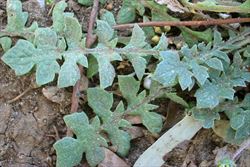
close-up of leaves showing deeply-lobed margins (Photo: Sheldon Navie)

close-up of hairy leaf underside (Photo: Sheldon Navie)

yellow flower-heads with darker centres (Photo: Sheldon Navie)
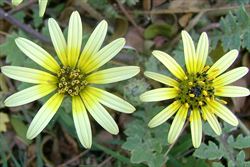
close-up of flower-heads (Photo: Sheldon Navie)

close-up of bracts at base of flower-head (Photo: Greg Jordan)
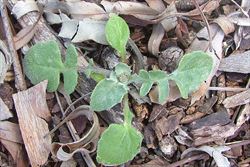
seedling (Photo: Sheldon Navie)
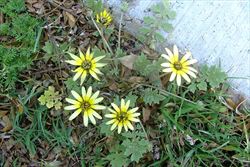
growing on the edge of a footpath in Taringa in Brisbane (Photo: Sheldon Navie)

close-up of flower-head with bright yellow 'petals' (Photo: Sheldon Navie)

close-up of fluffy 'seeds' (Photo: Sheldon Navie)
Scientific Name
Arctotheca calendula (L.) Levyns
Synonyms
Arctotis calendula L.Cryptostemma calendulaceum (L.) R. Br.
Family
Asteraceae (Queensland, New South Wales, the ACT, Victoria, Tasmania, Western Australia and the Northern Territory)Compositae (South Australia)
Common Names
Cape daisy, Cape dandelion, Cape marigold, Cape weed, Capeweed, marigold, plain treasure flower, silverspreader, South African Capeweed
Origin
Native to southern Africa (i.e. Lesotho and Cape Province and Natal in South Africa).
Cultivation
This species was widely grown as a garden ornamental in the past.
Naturalised Distribution
Widely naturalised throughout the southern, central and eastern regions of Australia. It is widespread and common in New South Wales, the ACT, Victoria, Tasmania, South Australia and the southern and western parts of Western Australia. Less common or scattered in Queensland and the southern parts of the Northern Territory.
Also naturalised on Norfolk Island and in many other parts of the world, including Europe, the Azores, New Zealand and south-western USA (i.e. California).
Habitat
A weed of rangelands, pastures, crops, orchards, gardens, lawns, sports fields, footpaths, roadsides, waste areas, bare ground, disturbed sites and natural areas (e.g. coastal environs, grasslands and open woodlands) in the temperate, semi-arid and sub-tropical regions of Australia. It is occasionally also found growing in arid and tropical regions.
Habit
A low-growing short-lived (i.e. annual) herbaceous plant with semi-upright (i.e. decumbent to ascending) flowering stems reaching up to 30 cm tall. Prior to flowering it is either stemless and forming a basal rosette, or has short creeping or sprawling stems.
Distinguishing Features
-
a low-growing short-lived plant with semi-upright flowering stems up to 30 cm tall.
-
its leaves (5-25 cm long and 2-6 cm wide) are somewhat elongated in shape with toothed to deeply lobed margins.
-
these leaves have hairless or slightly hairy upper surfaces and whitish, felty undersides.
-
its flower-heads (2-6 cm across) have dark-purplish coloured centres and numerous yellow 'petals' (1-2.5 cm long).
-
its 'seeds' (2-2.5 mm long) and densely covered in a brownish or pinkish coloured fluffy wool.
Seedling
Its two seed leaves (i.e. cotyledons) are hairless (i.e. glabrous) and narrowly club-shaped with rounded tips (i.e. narrowly-clavate). The first true leaves are spear-shaped (i.e. lanceolate) with lobed or bluntly toothed margins and whitish hairy undersides.
Stems and Leaves
Its flowering stems are loosely covered in white woolly hairs (i.e. they are loosely tomentose).
Its simple leaves are mostly basal and somewhat elongated in shape with toothed to deeply lobed margins (i.e. they are oblanceolate to lyrate-pinnatisect). These leaves (5-25 cm long and 2-6 cm wide) have hairless or slightly hairy (i.e. glabrous to mealy-pubescent) upper surfaces that are green in colour and whitish, densely felty-hairy undersides.
Flowers and Fruit
The flowering stems (i.e. peduncles) are 5-25 cm long and bear a single flower-head (i.e. solitary capitulum). These flower-heads (2-6 cm across) have a hemispherical base (about 15 mm across) that is surrounded by several rows of bracts (i.e. involucral bracts). The greenish-coloured bracts are slightly elongated in shape (i.e. broadly-lanceolate), the outer ones with hairy tips (i.e. ciliate apices) and the inner ones with membranous (i.e. scarious) margins. Each flower-head also has numerous tiny dark-purplish coloured tubular flowers (i.e. tubular or disc florets) in the centre that are surrounded by several large 'petals' (i.e. ray florets). The 'petals' (1-2.5 cm long) are pale yellow with brighter yellow bases and greenish or purplish coloured undersides. Flowering occurs mainly during late winter and spring (i.e. from August to November).
The dark brown 'seeds' (i.e. achenes or cypselas) are oblong in shape (2-2.5 mm long) and densely covered in a brownish or pinkish coloured fluffy wool. The top of the seed has a ring (i.e. pappus) of 6-8 tiny scales.
Reproduction and Dispersal
This species reproduces only by seed. The seeds are commonly dispersed short distances by wind and can also become attached to birds, animals, shoes and clothing. They are also spread to new areas in contaminated soil, dumped garden waste, by vehicles and machinery, and in contaminated agricultural produce (i.e. fodder).
Environmental Impact
Capeweed (Arctotheca calendula) is regarded as an environmental weed in Victoria, New South Wales, Western Australia, South Australia, the ACT and the Northern Territory. Though it is widely known as a very common weed of habitation (i.e. gardens and lawns) and agricultural areas (i.e. crops and pastures) in temperate Australia, it is also increasingly becoming a problem in natural areas (particularly in coastal environs and in semi-arid and arid regions).
In Western Australia populations of Capeweed (Arctotheca calendula) are increasing rapidly in the arid zone, and they are displacing ephemeral native species in these areas. It is also a significant problem in the rangelands of southern Australia, where it replaces more palatable native species, especially in areas that are overgrazed. Capeweed (Arctotheca calendula) is also present in numerous conservation areas (e.g. Swallow Lagoon Nature Conservation Reserve and Kinglake National Park in Victoria, Hale Conservation Park and Coffin Bay National Park in South Australia, Weddin Mountains National Park and Tumblong State Conservation Area in New South Wales, Fitzgerald River National Park in Western Australia and Tasman National Park in Tasmania) and it often poses a threat to the integrity of plant communities and the survival of threatened species in these sites.
For example, weed competition from this and other weed species is seen as one of the main threats to the vulnerable red darling pea (Swainsona plagiotropis) in the upper Murray River valley in southern New South Wales. It is also present in areas where the remaining known populations of Irwin's conostylis (Conostylis dielsii subsp. teres) are located east of Dongara in the Geraldton region in Western Australia (and is of particular concern to populations located in road reserves where weeds are more abundant). The mountain villarsia (Villarsia calthifolia), which is limited to the Porongurup Range in south-western Western Australia, is also under threat from several weed species, including Capeweed (Arctotheca calendula).
Capeweed (Arctotheca calendula) is also a common coastal weed in the Gulf St. Vincent area near Adelaide in south-eastern South Australia. It forms mats of vegetation in heavy soils in reardunes and also harbours pests that are a threat to native seedlings (e.g. red spider mite). It has also been reported as a weed of coastal sites in other parts of Australia (e.g. at Greens Beach Reserve in Tasmania and in coastal foreshores at Joondalup in Western Australia).
Other Impacts
Capeweed (Arctotheca calendula) is a troublesome weed in pastures, crops and home gardens. In newly sown pastures it can smother grass and clover seedlings, and in drier regions it can often dominate overgrazed pastures. Though it is of some use as a fodder, it dies off during summer leaving bare areas that are vulnerable to erosion and invasion by other weeds. It can also taint milk and high nitrate levels in plants have caused livestock deaths (e.g. sheep and cattle). It is also a major weed of crops in southern Australia and a common pest of lawns, sporting fields, golf courses and home gardens.
Legislation
Not declared or considered noxious by any state government authorities.
Management
For information on the management of this species see the following resources:
- the Tasmanian Department of Primary Industries and Water Weed Service Sheet on this species, which is available online at http://www.dpiw.tas.gov.au.
Similar Species
Capeweed (Arctotheca calendula) is very similar to the gazanias (Gazania linearis and Gazania rigens) and similar to beach daisy (Arctotheca populifolia) and white arctotis (Arctotis stoechadifolia). These species can be distinguished by the following differences:
- Capeweed (Arctotheca calendula) has elongated deeply lobed (i.e. lyrate-pinnatisect) leaves with green upper surfaces and whitish hairy undersides. Its flower-heads are relatively large (2-6 cm across) with dark purplish or black centres and 'petals' (i.e. ray florets) 10-25 mm long. These 'petals' are yellow with darker yellow bases and greenish or purplish coloured undersides.
- the gazanias (Gazania linearis and Gazania rigens) have elongated entire to deeply lobed (i.e. entire to pinnatisect) leaves with green or greyish upper surfaces and whitish hairy undersides. Its flower-heads are very large (6-12 cm across) with yellow or orange centres and 'petals' (i.e. ray florets) 30-50 mm long. These 'petals' are various colours and usually have darker bases.
- beach daisy (Arctotheca populifolia) has oval (i.e. elliptic) leaves with entire margins greyish-green hairy surfaces. Its flower-heads are relatively small (2-3.5 cm across) with yellow or orange centres and 'petals' (i.e. ray florets) 5-7 mm long. These 'petals' are entirely yellow in colour.
- white arctotis (Arctotis stoechadifolia) has elongated (i.e. lanceolate) leaves with the toothed (i.e. serrate) or deeply lobed (i.e. lyrate-pinnatisect) margins and greyish hairy surfaces. Its flower-heads are relatively large (4-6 cm across) with dark purplish or black centres and 'petals' (i.e. ray florets) 25-30 mm long. These 'petals' are creamy-white to light yellow with darker yellow bases (sometimes pink or purplish throughout) and maroon or mauve undersides.
Capeweed (Arctotheca calendula) is also very similar to creeping Capeweed (Arctotheca prostrata), which is only naturalised in Victoria. However, creeping Capeweed (Arctotheca prostrata) can be distinguished by its longer creeping stems and its flowers, which have yellow centres.

